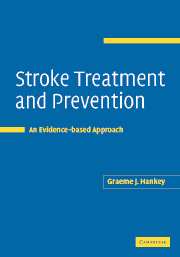Book contents
- Frontmatter
- Contents
- Preface
- 1 The size of the problem of stroke
- 2 Understanding evidence
- 3 Organised acute stroke care
- 4 General supportive acute stroke care
- 5 Reperfusion of ischaemic brain by thrombolysis
- 6 Augmentation of cerebral blood flow: fibrinogen-depleting agents, haemodilution and pentoxifylline
- 7 Neuroprotection
- 8 Treatment of brain oedema
- 9 Anticoagulation
- 10 Antiplatelet therapy
- 11 Carotid artery revascularisation
- 12 Lowering blood pressure
- 13 Lowering blood cholesterol concentrations
- 14 Modification of other vascular risk factors and lifestyle
- 15 Antithrombotic therapy for preventing recurrent cardiogenic embolism
- 16 Arterial dissection and arteritis
- 17 Treatment of intracerebral haemorrhage
- 18 Treatment of subarachnoid haemorrhage
- References
- Index
1 - The size of the problem of stroke
Published online by Cambridge University Press: 23 December 2009
- Frontmatter
- Contents
- Preface
- 1 The size of the problem of stroke
- 2 Understanding evidence
- 3 Organised acute stroke care
- 4 General supportive acute stroke care
- 5 Reperfusion of ischaemic brain by thrombolysis
- 6 Augmentation of cerebral blood flow: fibrinogen-depleting agents, haemodilution and pentoxifylline
- 7 Neuroprotection
- 8 Treatment of brain oedema
- 9 Anticoagulation
- 10 Antiplatelet therapy
- 11 Carotid artery revascularisation
- 12 Lowering blood pressure
- 13 Lowering blood cholesterol concentrations
- 14 Modification of other vascular risk factors and lifestyle
- 15 Antithrombotic therapy for preventing recurrent cardiogenic embolism
- 16 Arterial dissection and arteritis
- 17 Treatment of intracerebral haemorrhage
- 18 Treatment of subarachnoid haemorrhage
- References
- Index
Summary
Stroke is an enormous and serious public health problem. It is the third most common cause of death in the world, after ischaemic heart disease and all types of cancer combined. Stroke caused 4.4 million deaths in 1990, and two thirds of these occurred in less developed countries (Murray and Lopez, 1996, 1997). Stroke is also the most important cause of disability among adults. The estimated prevalence of stroke-related disability is more than 0.6% of the population of the world, which represented 3% of the world's disability burden in 1990 (Murray and Lopez, 1996, 1997; Lopez and Murray, 1998).
In the USA in 1994, stroke was the second most common cause of death, the fourth greatest cause of disability-adjusted life years, the fifth highest consumer of days in hospital, the fifth most prevalent major disorder and the eighth most commonly occurring disorder (incidence) (Gross et al., 1999).
Stroke is therefore costly (and becoming increasingly costly) to health care systems. It is estimated that stroke accounts for 4–6% of health care budgets, excluding the costs of social services and carers. Stroke accounts for almost 6% of total health care costs in Finland, 5% in the UK and over 3% in the Netherlands (Isaard and Forbes, 1992; Taylor et al., 1996; Evers et al., 1997; Dewey et al., 2001; Payne et al., 2002; Levy et al., 2003; Evers et al., 2004; Martinez-Vila and Irimia, 2004).
- Type
- Chapter
- Information
- Stroke Treatment and PreventionAn Evidence-based Approach, pp. 1 - 8Publisher: Cambridge University PressPrint publication year: 2005
- 1
- Cited by



